« July 2007 | Main | October 2007 »
August 29, 2007
The Tower on the Hill of Allen
Known locally as “Aylmer’s Folly,” The Tower was the strange idea of a man who was in the year 1798, Sir Gerald George Aylmer, of Donadea Castle, Co. Kildare.
Commenced in 1859, the work of building the Tower continued during the summer months only of the subsequent four years, as the position was too exposed for masonry work during the winter. There does not appear to have been any architect or engineer.
PURPOSE UNCERTAIN
Two masons named Lawrence and William Gorry, brothers, built the Tower, and their names are cut on the landing at the top of the stairs. The purpose for which the tower was erected is uncertain. William Gorry had been bound to the trade at the age of sixteen years, in the year 1846. He frequently worked at Donadea Castle, and often told how Sir Gerald would look across from there to Allen hill and say “I’ll build something on that.” He would examine the work as it proceeded, and tell the masons that it was better to spend his money giving employment than paying engineers.
The Hill of Allen lies about five miles to the north of Kildare, and commands an extensive view of the Dublin, Wicklow and Slieve Bloom mountains, as well as the Curragh plains, and the surrounding immense bog to which it gives its name. It is renowned as having been the site of the royal residence of the famed champion, Finn Mac Cumhail, a real historical character that flourished there in the latter end of the 3rd century.
FAINT TRACES
There are now but faint traces to indicate the site of the royal palace. The summit of the Hill is very level and was formerly surrounded by earth entrenchments. A small mound called Suidh-Fionn, Finn’s Chair, occupies the highest point, and in its centre stands the Tower.
In an age when labour-saving machinery and materials were unknown the erection of the Tower on such an elevation must have been a formidable undertaking. When digging the foundations the workmen discovered a cave, nine feet deep, filled with soft clay at the bottom of which they came upon a remarkably large human skeleton, which was believed in the neighbourhood to have been that of the giant Finn MacCumhail.
The Tower is about 60 feet high, the base of it being 676 feet above sea-level, and the internal diameter is 9 feet. It is built of limestone, quarried and cut at Edenderry, and brought from there to Robertstown by canal, and carted to the Hill by Sir Gerald’s tenants. He promised that their names would be cut as “an everlasting memorial” on the steps of the Tower. There are eighty-three steps, and on each one name is inscribed, making a list in stone of the ancestors of many families still living in the Allen district.
FROM BALLYKNOCKAN
Three canons formerly stood at Donadea Castle, and from one of these the wheels were borrowed for the four-wheeled lorry which conveyed the stones to the top of the Hill. The granite coping and steps, and the pedestal of the table at the top of the Tower, came from Ballyknockan, CoWicklow, and the limestone table from Edenderry. On the Hill of Allen itself was quarried the stone which lines the tower.
William Gorry and his brother completed their work by placing a copper-framed glass dome on the tower, and a railing around the building.
On the outside of the tower numerous inscriptions are scattered, and on the flags inside the iron railing the visit of the then Prince of Wales, afterwards Edward VII is recorded: “September 16 A.D. 1861 H.R.H. The Prince of Wales ascended this Tower.” The Prince was stationed at the Curragh during the year 1861, and on August 24th of that year Queen Victoria reviewed the troops at the Camp.
Inside the tower at the top of the stairs, is the following inscription:-
“In thankful remembrance of God’s mercies, many and great- Built by Sir Gerald George Alymer, Baronet, A.D. 1860”: and on the top landing: “Lawrence and William Gorry, Bros., Masons.” Then on the top steps are the words “assisted by” and the names of the tenants are given on the steps as follows: - James Dowling, Allenwood: Anne Healy, Allenwood: Wilson Symonds, Allenwood, Thomas Baker, Allenwood, Patrick Logan, Allenwood, John Tiernan, Allenwood: Michael Gannon, Allenwood: Thomas Culleton, Allenwood: James Walsh, Allenwood: William Flynn, Allenwood: Denis Healy, Ballentine: John Tiernan, Ballentine: William Lazenby, Ballentine: Mel Somers, Ballyteague: Christ. Healy, Ballyteague: Peter Healy, Ballyteague: Edmond Hegarty, Ballyteague: Edward Payne, Ballyteague: James Doyle, Ballyteague: John Thornton, Ballyteague: James Hennigan, Ballyteague: Patrick Moran, Ballyteague: Francis Dowling, Barnecrow: James Carroll, Barnecrow: Francis Dowling, Baronstown: George Low, Baronstown: Thomas Flood, Carrick: James Walsh, Carrick: George Wilson, Carrick: Elizabeth Knowles, Carrick: James Doogan, Carrick: Patrick Lennon, Cloncumber: Thomas Hynes, Cloncumber: Robert Strong, Coolagh: Thomas Carter, Coolagh: Joseph Strong, Coolagh: John Rochford, Coolagh: Patrick Callan, Derrymullen: Bridget Mulhall, Derrymullen: Thomas Harbert, Derrymullen: Joseph Payne, Drimshree: Peter Cribbin, Drimshree: Michael Thorpe, Drimshree: Samuel Strong, Dunburne: William Wilson, Dunburne: Hugh Kelly, Dunburne: James Dowling, Dunburne: Patrick Dunn, Dunburne: Charles Ryan, Dunburne: James Norton, Grangeclare: William Price, Grangeclare: James Carter, Grangeclare: John Fitzpatrick, Grangeclare: Michael Connor, Grangeclare: Joseph Nevitt, Grangeclare: Joseph Carter, Grangeclare: Thomas Carter, Grangeclare: George Price, Grangeclare: William Tyrell, Grangeclare: Lawrence Behan, Grangeclare: James Brennan, Grangeclare: John Lazenby, Grangeclare: William Ormsby, Grangeclare: Christopher Hickey, Grangeclare: John Cribben, Grangeclare: Ed. Nowlan, Grangehiggin: Matthew Nowlan, Grangehiggin: Peter Noylan, Kilmeague: William Curtis, Kilmeague: Stephenson Haslam, Kilmeague: Matthew Lazenby, Kilmeague: John Healy, Kilmeague: Christopher Quinn, Littleton: Marcella Cribbin, Lowtown: Lawrence Cribbin, Lowtown: Matthew Knowles, Pluckerstown: Denis Dunny, Pluckerstown: John Dunny, Pluckerstown: Patrick Hickey, Rathernan: Richard Kelly, Rathernan: Catherine Healy, Russellstown: Peter Healy, Russellstown.
Posted by mariocorrigan at 11:06 AM
Cill Dara Historical Society Talk - Hill of Allen by Sean Byrne
Cill Dara Historical Society
Kildare Town's Local History Group
presents
The Hill of Allen
with
Sean Byrne
Wednesday 5th September
8 p.m. Kildare Education Centre (Old Parochial House)
Friary Road, Kildare Town
Sean Byrne having delivered an excellent talk in 2006 on Kilmeague, returns to Kildare Town with a talk on the Hill of Allen which is being hosted by Cill Dara Historical Society, Wed. 5th Sept. 2007
Posted by mariocorrigan at 10:47 AM
August 24, 2007
UNVEILING OF GREY ABBEY MONUMENT 22 AUG 2007
New Monument at Grey Abbey
At the Annual Graveyard Mass at Grey Abbey on Wednesday night, 7.30 p.m., 22 August 2007 a monument was unveiled to all those buried without record at Grey Abbey. Mass was consecrated by Parish Priest Fr. Adrian Carbery and Fr. Loughlin Flanagan. Fr. Carbery invited Fr. Flanagan to lay a wreath at the monument to commemorate all those who were buried in the graveyard but whose graves lie unmarked or unrecorded.
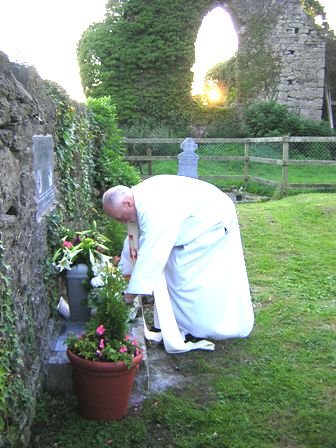
The monument was erected by the Grey Abbey Conservation Project and paid for from the proceeds of the ‘Church of the Oak’ book which was published late in 2006. It is hoped that the monument will provide a place for people to say a prayer or lay a wreath or flower in memory of their loved ones as so many people were buried there but it is impossible to locate the exact location of all the graves.
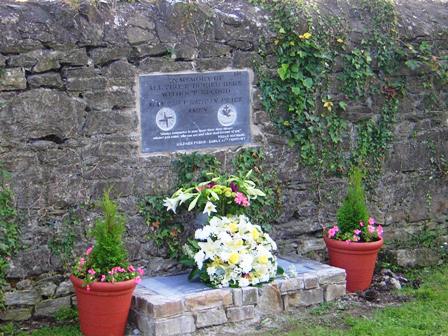
The beautiful monument was sculpted by local stone mason Sean Daly. It simply states
ALL THOSE BURIED HERE WITHOUT RECORD
AMEN.
whence you come, who you are and what shall become of you.
Kildare Poems – Early 14th Century
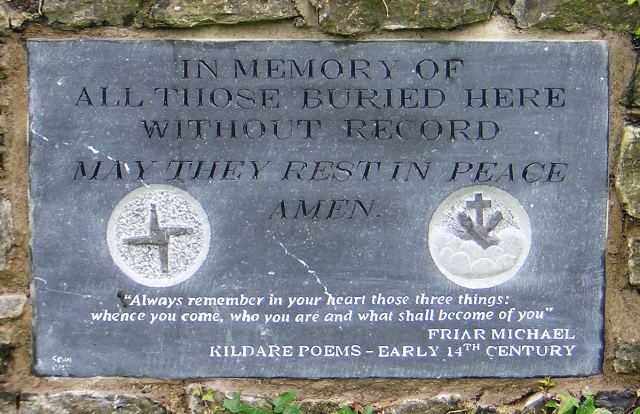
There are two crests - one a St. Brigid’s Cross representing the Parish of Kildare and the second, the Franciscan crest, as Grey Abbey was a Franciscan foundation. The latter crest was graciously supplied at extremely short notice by Fr. Ignatius Fennessy of the Franciscan Order, at their Library in Killiney - our sincerest thanks.
The wreath was supplied by Violets flowers shop and the plants each side were supplied by Guilfoyles Garden Centre - a truly local venture which was important to the Project from the outset. The Project is also grateful tothe Environment Section and National Monuments Advisory Committee of Kildare County Council who gave permission for, and advice on the erection of the monument.
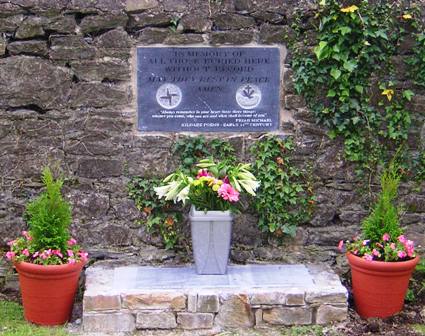
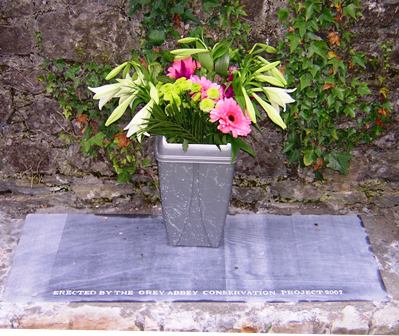
The Council have also granted permission to have the gates restored and re-hung and it is hoped this will be accomplished in the next few weeks; once again this will be paid out of the proceeds of the book which also allowed the Project to purchase a new strimmer and lawn mower in 2007. Special tribute must be made to Paddy and Frank who look after the graveyard and had it looking absolutely beautiful for the mass. We would also like to thank Christy who was involved in this work until recently.
To all those who have helped along the way, especially Joe Connelly and the Cill Dara Historical Society, to all those who bought the book and the people of Kildare Town generally who have supported us throughout - THANK YOU.
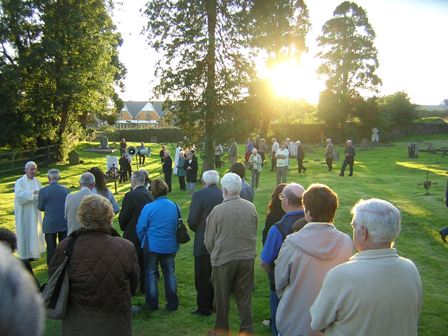
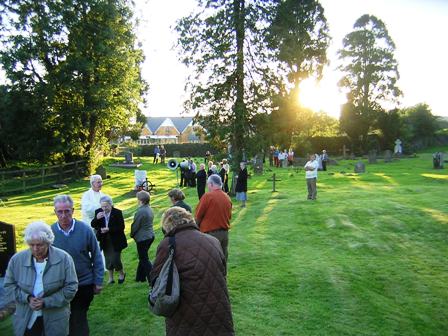
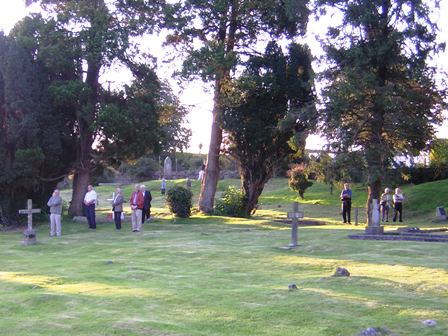
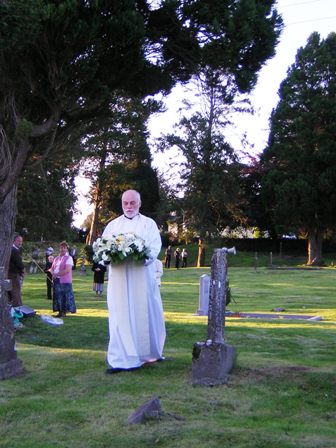
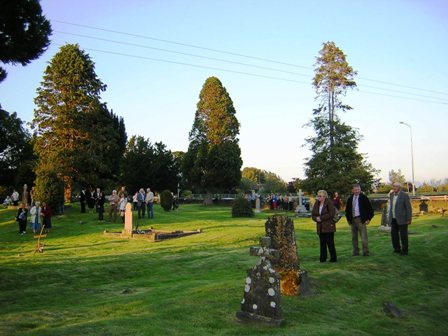
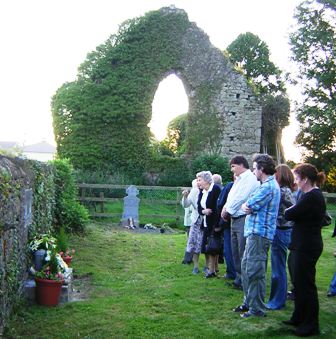
Posted by mariocorrigan at 01:44 PM
August 08, 2007
Unions rebel in Kildare in 1936
An interesting mention in the Leinster Leader of December 1936 of labour force unrest in Kildare Town.
Posted by mariocorrigan at 12:26 AM
August 01, 2007
A long way from the front!
Interesting newspaper advert for a carnival in St. Brigid's Park as the war ends in Europe in June 1945.
Posted by mariocorrigan at 12:21 AM